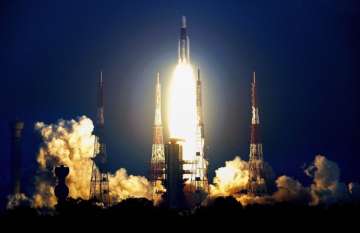The Indian Space Research Organisation (ISRO) on Wednesday successfully launched India’s heaviest rocket GSLV-MkIII-D2 carrying communication satellite GSAT-29 from Satish Dhawan Space Centre in Sriharikota.
GSLV-MkIII-D2 successfully injected GSAT-29 into Geosynchronous transfer orbit , ISRO said in a statement.
The 27-hour countdown for the launch began at 2.50pm Tuesday and the rocket blasted off at 5.08 pm from the spaceport at Sriharikota over 100 km from Chennai.
The 3,423 kg GSAT-29 carries Ka and Ku band high throughput transponders which will provide communication services to remoTe places in the North East and Jammu and Kashmir, besides aid the Centre’s Digital India programme, ISRO chief K Sivan said.
In addition, several new technologies such as Q/V-band payload, data transmission through optical communication link will be demonstrated. This will help in realising future advanced satellites, ISRO said.
Prime Minister Narendra Modi congratulated ISRO scientists for the successful launch and said that the satellite will provide communication and internet services to the remotest corners of India.
“My heartiest congratulations to our scientists on the successful launch of GSLV MK III-D2 carrying GSAT-29 satellite. The double success sets a new record of putting the heaviest satellite in orbit by an Indian launch vehicle,” he tweeted.
“The satellite will provide communication and internet services to the remotest corners of our country,” he added.
ISRO scientists broke into cheers as the satellite was injected into a geosynchronous orbit, 16 minutes after lift-off.
Sivan said the country had achieved a significant milestone following the successful launch and the injection of the satellite into the GTO was ‘precise.’ “I am extremely happy to declare that our heaviest launcher in its second mission has lifted the heaviest satellite, GSAT 29 from Indian soil, and after a majestic travel of 16 minutes, it precisely injected it into the intended Geo Transfer Orbit,” he said.
ISRO scientists had termed the launch crucial for the space agency as the rocket would be used for the ambitious Chandrayaan-2 and the country’s manned space missions.
Sivan said while the launch vehicle’s first operational mission was going to be “none other than Chandrayaan” in January 2019, “this fantastic vehicle is going to carry humans to space in three years from now.” Cyclone Gaja had clouded the launch plans but with it changing course and conducive weather conditions prevailing, the rocket blasted off on schedule.
The satellite would be placed in its final Geostationary Orbit using the on-board propulsion system and it may take a few days after separation from launcher to reach the orbital slot, ISRO said.
The GSLV-MkIII-D2 is a three stage launch vehicle with two solid strap-ons, a liquid core stage and a cryogenic upper stage.
Compared to solid and liquid stages, the C25 cryogenic stage is more efficient as well as complex. According to ISRO, the GSAT-29 satellite is intended to serve as a test bed for several new technologies. It is specifically designed to cater to communication requirements of users from remote areas of the country. The mission life is about 10 years.
GSLV-MkIII is the fifth generation launch vehicle developed by ISRO and is designed to place satellites of upto 4,000 kg in GTO.
Watch: ISRO’s heavy-lift rocket GSLV-MkIII-D2 blasts off from Sriharikota
The launch vehicle is the 67th launch mission from the Satish Dhawan Space Centre at Sriharikota and the 33 communication satellite built by ISRO for which this will be the fifth launch this year.
(With agency injputs)
Latest India News
